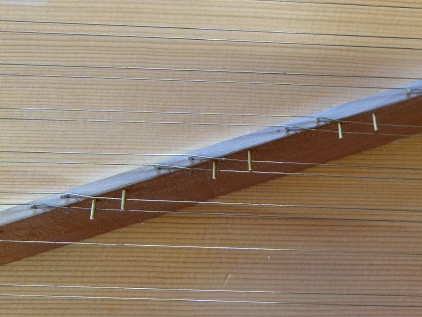Technical Library
STRINGING XI: Backpinning
Entire Contents Copyright © 2012 CBHTechnical LibrarySTRINGING XI: Backpinning Entire Contents Copyright © 2012 CBH |
 CAREY BEEBE |
Typical English backpinning with larger diameter bent pins |
Backpinning…
Backpinning is a design feature in the bass and tenor of many harpsichords. Flemish and 18th-century French harpsichords used backpinning to help couple the strings in that region firmly to the bridge. The treble strings normally make their way from the crown of the bridge to a lower hitchpinrail along the bentside at angles providing both downbearing and sidebearing, so no backpinning is required. In contrast, the tenor and bass usually have a higher hitchpinrail, and the strings run straight over the bridge. Here, the tension of the strings running under the backpins lifts the bridge and tends to rotate it slightly towards the spine.
There is considerable variation possible in backpinning, both in location of the pins, and their angle.
The picture at the right shows typical English backpinning on an original bentside spinet, using larger diameter brass pins than the bridgepins for the backpinning, and bending the backpins over the string.
To help control a wayward soundboard, sometimes backpinning can be extended higher up the compass than originally fitted.
If the angles made by the string running between bridgepin and backpin are too great, there is the possibility of tuning difficulty because of increased friction. In extreme circumstances, the intended string material or diameter may not even be able to be used because the severe backpinning imposes far too much strain on the wire, leading to premature breakage. Also, it is entirely possible that the cramping effect of many strings can impart unexpected rigidity to the soundboard and stifle the tone.
These instruments can be much improved tonally by removing the original backpinning, plugging the holes in the bridge by gluing in matching wood sticks for neatness, and relocating the backpins to provide gentler angles.
The photos below show the visual difference before and after on a French Double Harpsichord by David Rubio, Cambridge 1982. Looking from above, the original backpinning scheme forced the wire into a distinct reverse Z-shaped track, causing drag on the pins and confining the bridge. It was easy to demonstrate the rigidity of the soundboard by trying to push down gently on the bridge, but it was almost unmovable. The freedom of soundboard movement with the revized backpinning allowing the strings to run almost in a straight line over the bridge was astonishing to see, and immediately reflected in the new open tone of the harpsichord.
 CAREY BEEBE |
 CAREY BEEBE |
|
| Severe backpinning on the 8´ bridge | Revized backpinning with strings almost running straight |
| Backpinning the 8´ bridge Carey Beebe backpinning the 8´ bridge. |
|||
| Technical Library overview | |
| Harpsichords Australia Home Page |